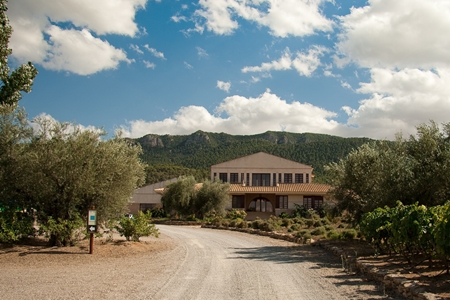Well, I don’t know about you, but I do like a change from time to time. One of the great delights of wine is that you can explore the byways of the wine world and the lesser-known grapes.
You don’t need to be an expert either. Just look for something unfamiliar that suits your budget and give it a try. Perhaps this column should have been called “Grapes less Trampled” but it wouldn’t have sounded quite as romantic.
 Casa de la Ermita Winery, Jumilla.
Casa de la Ermita Winery, Jumilla.
A little to the north of the Spanish university-town of Murcia and about forty miles west of Alicante are the vineyards of Jumilla. Eighty-five percent of the vineyard area is devoted to the Monastrell grape.
Casa de la Ermita Monastrell (red), Spain (Bt. 550 @ Wine Connection)
If the name Monastrell sounds unfamiliar, it is simply the more familiar French Mourvèdre wearing a mantilla. The grape appears in large areas of southern Spain including Valencia and Murcia. These small, thick-skinned, black grapes love the scorching sunlight of Jumilla’s hot plains and they produce brooding, tannic and earthy wines with high alcohol and distinctive fruit flavours.
Founded by Pedro Martin in 1999, the wine company Casa de la Ermita uses modern, temperature-controlled vinification techniques which bring out the deep, rich flavours from the old Monastrell vines that grow in the local Jumilla vineyards.
This is a fine example of a big, bold, un-oaked 100% Monastrell wine. It’s organic too, which means that the grapes are grown in accordance with the principles of organic farming. The wine is a deep garnet-red, with aromas of brambly black fruit and red currants. Distant aromas of herbs and spices waft out of the glass too. There’s even a hint of licorice. The wine has a very smooth mouth-feel, with a satisfying layer of ripe tannin underneath. It’s a very dry and clean-tasting wine, but with loads of fruit, spices and pepper. There’s a long dry spicy finish too. You’ll need to give this wine plenty of time to breathe. It’s not enough to simply remove cork a few minutes in advance, even though you see this done in restaurants all the time. It’s pointless, because the air can make contact only with the tiny surface area of wine in the neck of the bottle. And quite frankly, this doesn’t make a great deal of difference. Ideally, tip the whole bottle into a decanter or wine jug, and give it at least forty minutes for the oxygen to get to work.
Some people improve on acquaintance, and this wine also takes a bit of time to reveal itself, so don’t rush it. After about an hour, the softness comes through and you’ll find that this wine is a real charmer. It’s quite authoritative in a Brahms-like sort of way, but has soft edges and elegant firm tannins. Not surprisingly, it will be at its best with food, such as slow-cooked red meat dishes or even game.
Terra Andina Carmenère 2008 (red), Chile (Bt. 455 @ Friendship)
Known as the “Lost Grape of Bordeaux”, the Carmenère is the darkest and purplest of all red grapes. At the end of the 19th century, it found a new home in Chile, where it is now something of a national treasure. In the hands of Stefano Gandolini, the chief wine-maker at Terra Andina (it means “Land of the Andes”), the Carmenère makes a lovely supple, peppery wine.
This deep red wine is 100% Carmenère and you’ll probably notice tinges of violet in the glass. It announces itself with a delicate aroma of black berry fruit, plums and pepper. There’s plenty of fruit on the palate, notably spicy berries and a brambly touch of cedar, because the wine was matured for a couple of months in various French and American oak casks. The wine is very dry, with pepper and spices but typically for a Carmenère, the tannins are very soft. There’s a slightly peppery mouth-feel too and a very long, pleasingly dry finish which brings a touch of mild spice. It’s medium-bodied, with a high alcohol content of 13.5%, and the distinctive refreshing quality would make it ideal for pizza, pasta or rich tomato-based dishes, as well as roasted and grilled meat.
But here’s something amazing. For decades, the Chileans mistook this grape for some kind of Merlot. It wasn’t until 1994 that Chilean winemakers realised that their Merlot was the legendary “Lost grape of Bordeaux”, the Carmenère. They haven’t looked back.




